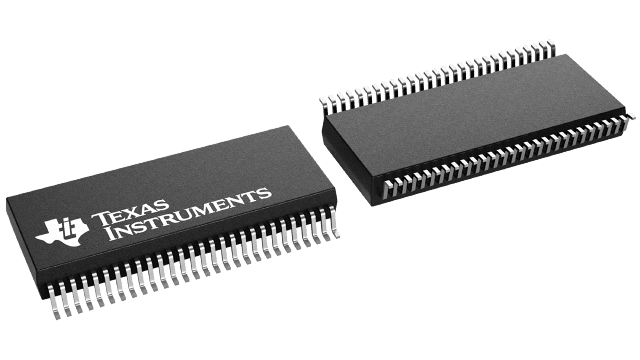패키징 정보
| 패키지 | 핀 SSOP (DL) | 56 |
| 작동 온도 범위(°C) -55 to 125 |
| 패키지 수량 | 캐리어 1,000 | LARGE T&R |
SN74LVTH16543-EP의 주요 특징
- Controlled Baseline
- One Assembly/Test Site, One Fabrication Site
- Enhanced Diminishing Manufacturing Sources (DMS) Support
- Enhanced Product–Change Notification
- Qualification Pedigree(1)
- Member of the Texas Instruments Widebus™ Family
- State–of–the–Art Advanced BiCMOS Technology (ABT) Design for 3.3–V Operation and Low Static–Power Dissipation
- Supports Mixed–Mode Signal Operation (5–V Input and Output Voltages With 3.3–V VCC)
- Supports Unregulated Battery Operation Down to 2.7 V
- Ioff and Power–Up 3–State Support Hot Insertion
- Bus Hold on Data Inputs Eliminates the Need for External Pullup/Pulldown Resistors
- Typical VOLP (Output Ground Bounce)
<0.8 V at VCC = 3.3 V, TA = 25°C - Distributed VCC and GND Pins Minimize High–Speed Switching Noise
- Flow–Through Architecture Optimizes PCB Layout
- Latch–Up Performance Exceeds 500 mA Per JESD 17
- ESD Protection Exceeds 2000 V Per MIL–STD–883, Method 3015; Exceeds 200 V Using Machine Model (C = 200 pF, R = 0)
(1)Component qualification in accordance with JEDEC and industry standards to ensure reliable operation over an extended temperature range. This includes, but is not limited to, Highly Accelerated Stress Test (HAST) or biased 85/85, temperature cycle, autoclave or unbiased HAST, electromigration, bond intermetallic life, and mold compound life. Such qualification testing should not be viewed as justifying use of this component beyond specified performance and environmental limits.
Widebus Is a trademark of Texas Instruments
SN74LVTH16543-EP에 대한 설명
The SN74LVTH16543 is a 16–bit registered transceiver designed for low–voltage (3.3–V) VCC operation, but with the capability to provide a TTL interface to a 5–V system environment. This device can be used as two 8–bit transceivers or one 16–bit transceiver. Separate latch–enable (LEAB or LEBA) and output–enable (OEAB or OEBA) inputs are provided for each register to permit independent control in either direction of data flow.
The A–to–B enable (CEAB) input must be low to enter data from A or to output data from B. If CEAB is low and LEAB is low, the A–to–B latches are transparent; a subsequent low–to–high transition of LEAB puts the A latches in the storage mode. With CEAB and OEAB both low, the 3–state B outputs are active and reflect the data present at the output of the A latches. Data flow from B to A is similar, but requires using the CEBA, LEBA, and OEBA inputs.
Active bus–hold circuitry is provided to hold unused or floating data inputs at a valid logic level.
When VCC is between 0 and 1.5 V, the device is in the high–impedance state during power up or power down. However, to ensure the high–impedance state above 1.5 V, OE should be tied to VCC through a pullup resistor; the minimum value of the resistor is determined by the current–sinking capability of the driver.
This device is fully specified for hot–insertion applications using Ioff and power–up 3–state. The Ioff circuitry disables the outputs, preventing damaging current backflow through the device when it is powered down. The power–up 3–state circuitry places the outputs in the high–impedance state during power up and power down, which prevents driver conflict.
